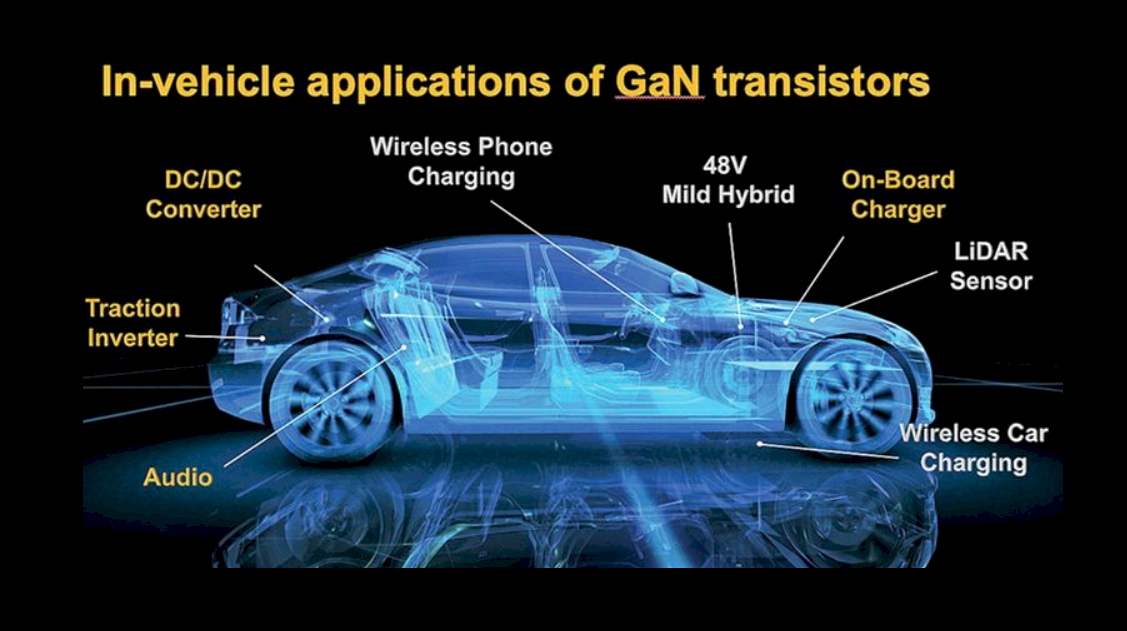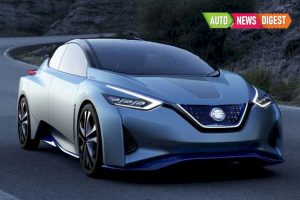Auto manufacturers are researching, testing, and toying with many new current trends and technological advancements in the auto industry. How many of these latest innovations will we see in our next car, is yet to be seen. Here are some potential innovations that could come to fruition in 2024:
Electric and Autonomous (with GaN)
Recently Renault CEO’s message to the auto industry was that car engines are dying, the future is electric. He said: “All the money is going into electric or hydrogen technology,” Luca de Meo told car show event in Germany . Electric and autonomous vehicles will become more commonplace and affordable, with many major automakers expanding their EV lineups and developing advanced autonomous driving systems.
What the leading the new innovation drive is GaN.
Gallium Nitride (GaN) is a semiconductor material that has been gaining popularity in the power electronics industry due to its superior performance compared to traditional silicon-based materials. In the electric car industry, the adoption of GaN technology has the potential to bring about several innovations, including:
GaN-based power electronics offer much higher efficiency, since they have lower resistance, enabling electric cars to achieve better efficiency and reduce energy waste. This can lead to increased range and reduced charging time.
GaN-based chargers can be smaller and lighter than traditional chargers due to their higher power density, and again reduced energy waste. This can make charging stations more accessible and portable, improving the convenience of electric car ownership.
Mercedes Benz research and investment in GaN-based inverters has been due to the fact that it can handle higher power output, enabling electric cars to accelerate faster and perform better overall, a key selling factor for high performance cars such as S500.
One of the major problems of batteries has been memory effect (leaking power and not charging to full max as time goes on). Lithium Ion is better than lead-based batteries but still has the same issue. GaN-based chargers can charge batteries more efficiently, reducing heat generation during charging, and thus extending the lifespan of the battery.
Since Lithium Ion does have some heat problems and it is a toxin, GaN-based power electronics can operate at higher temperatures without overheating, improving the safety of electric cars, and is not a natural toxin in its product-form.
Overall, the adoption of GaN technology in the electric car industry has the potential to improve the performance, increase efficiency, reduce heating and ‘memory effect’, and offer more effective electric vehicles, helping to accelerate the transition to a more sustainable transportation system.
Augmented Reality
The integration of augmented reality (AR) technology into car dashboards and windshields, providing drivers with real-time information on navigation, traffic, and weather conditions.
The innovative projection technology will use a dark-coated area at the lower edge of windshields to display information relevant to the driver and the passengers with a higher light intensity and higher contrast.
There is also panoramic vision covering the entire windshield. This particular technology is currently being tested at BMW and will soon be part of the iDrive control system in Neue Klasse EVs from BMW. This features a number of augmented reality surfaces in their cars and will begin arriving in the second half of 2025.
This is expected to be quite revolutionary and it won’t be just a fancier instrument panel that will show vehicle speed.
BMW intends to make windscreen become a single large display opening up completely new possibilities for the design of thier vehicles. Drivers will be given the option to decide which information they want to display in their own field of vision, or that all occupants can see the entire content.
Advanced Standard Features
Advanced safety features, such as smart headlights and emergency braking systems, will become standard in more vehicles. This would also included 5G network infrastructure integration and will enable better connectivity between vehicles and their surrounding environment, allowing for more efficient traffic management and communication between cars.
Some other features that are expected to be on the ‘standard’ list include:
- Even more advanced Driver Assistance Systems (ADAS) – if you thought that was possible: Features like lane departure warning, blind spot detection, accident avoidance, and automatic emergency braking are already becoming standard in some highend new vehicles, but more advanced ADAS systems could become commonplace in the future for all cars, just like airbags are today. Additiona features could include adaptive cruise control, which adjusts speed based on traffic flow, and pedestrian detection systems.
- Car buyers keep insisting on Integrated Connectivity (5G and other networking features): In the future, it’s likely that cars will become even more connected than they are today, including integrated Wi-Fi hotspots, compatibility with smart home devices, and even augmented reality dashboards as discussed above.
- Advance charging and power rating of Electric Powertrains: As more automakers transition to electric vehicles, it’s possible that electric powertrains could become standard equipment in many models. This would likely include fast charging capability and longer ranges, making electric vehicles more practical for everyday use.
- Sustainable Materials used in manufacturing can save money and this can be passed on to consumers: Automakers are increasingly turning to sustainable materials in vehicle production, and it’s possible that eco-friendly materials could become standard equipment in the future. This could include recycled plastics, plant-based materials, and more.
- Biometric Security Features and theft monitoring and avoidance systems: In order to prevent theft and improve safety, automakers may start to integrate biometric security features into standard equipment. This could include features like facial recognition or fingerprint scanners to unlock and start the vehicle, and a comprehensive vehicle tracking system.
Hydrogen Cell Technology
The continued development of hydrogen fuel cell technology, which could eventually provide a viable alternative to battery-powered electric vehicles. Hydrogen fuel cell technology has the potential to offer a practical and sustainable alternative to traditional gasoline-powered vehicles.
While there are still challenges to be addressed, ongoing advancements in this technology could help make hydrogen fuel cell vehicles a more viable option for drivers in the future.
No one can ignore the fact that lithium ion batteries are toxic for the environment and a toxin to humans. As we produce more and more cars this century, this problem will become more profound.
Hydrogen fuel cell technology is being researched extensively as an alternative to lithium ion battery systems and the traditional internal combustion engines.
While battery-powered electric vehicles has the potential to offer a zero-emissions solution for transportation, potential future developments in hydrogen fuel cell technology for cars offer much better prospects:
As the technology continues to improve, hydrogen fuel cell systems are becoming more efficient, allowing cars to travel further on a single tank of hydrogen. Future advancements could lead to even higher efficiency, which could help make hydrogen-powered vehicles more practical for everyday use.
One of the biggest challenges facing hydrogen fuel cell vehicles is the lack of infrastructure for refueling, as there are not enough refueling stations nor even the complete technology for a practical integration into the society for consumer use.
However, as more automakers invest in this technology, it’s possible that more hydrogen refueling stations will be built, making it easier for drivers to use these vehicles.
lthough at the moment the high cost of producing hydrogen fuel cell systems is a major barrier to widespread adoption, it is assumed that this will not be the case permenantly. Advancements in manufacturing and economies of scale could help drive down costs, making these vehicles more accessible to the consumers at a cost that is practical.
Hydrogen fuel cell vehicles are already known for their smooth and quiet operation, but research currently devoted to coming up with advancements that could lead to even better performance. For example, better acceleration and handling could make these vehicles more appealing to performance-oriented drivers.
Currently BMW, AUDI, Mercedes Benz, Toyota and a few other companies are offering models of hydrogen fuel cell vehicles and even fewer with models that are available on the market for purchase.
However, as more automakers invest in this technology, it’s possible that we’ll see a wider range of models and options, making it easier for consumers to find a hydrogen fuel cell vehicle that meets their needs.











